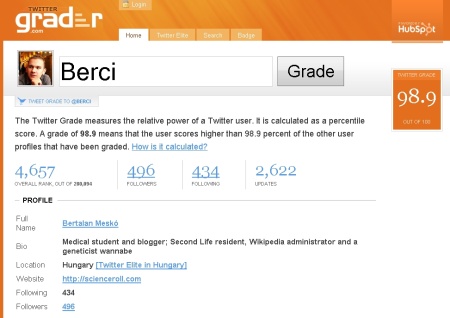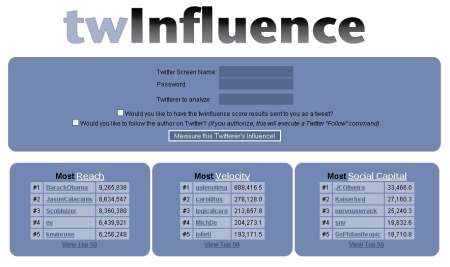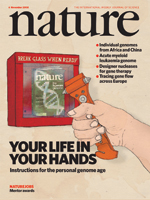The DNA Network |
| A helping hand for physicians [The Navigator - Navigenics Blog] Posted: 07 Nov 2008 10:02 PM CST Vance Vanier, M.D.
In a major advancement for the burgeoning genetic testing industry, the American College of Preventive Medicine has announced it is creating a medical education program on the use of genomic tools in medicine. Called "Genetic Risk, Screening and Intervention," the course is aimed at improving physicians' understanding of the use of genetic testing in disease prevention. Available in early 2009, the class will discuss the genetic risk factors for disease, as well as the current evidence about the ability of genetic tests to assess risk. This is an exciting time for the field of medicine. "We are beginning to see healthcare's evolvement from a discipline focused primarily on treating existing diseases and conditions to one that gives equal credence to preventing those diseases in the first place," said Michael Barry, executive director of the American College of Preventive Medicine. "We are excited to be helping physicians on the frontline of care become more familiar with multiple risk assessment strategies and the evidence behind new technologies—including genomic applications—that can help patients better understand their risk for disease and take appropriate actions to mitigate that risk," he said. To that end, national experts in genomics, prevention and epidemiology are designing the course to explore many issues related to genetic testing and disease prevention, including: |
| Coffee Break Science Browsing [adaptivecomplexity's blog] Posted: 07 Nov 2008 03:52 PM CST What I would have been reading over coffee in the lab, if I actually drank coffee in the lab (and of course I scrupulously follow the university Environmental Health&Safety rules and never drink coffee in the lab): At spiked, a review of Quantum: Einstein, Bohr, and the Great Debate About the Nature of Reality: The Nobel Prize-winning physicist Murray Gell-Mann believes that 'Bohr brainwashed a whole generation of physicists... |
| Tips and Tricks: Is Twitter reliable? [ScienceRoll] Posted: 07 Nov 2008 03:03 PM CST Last week, when I talked about the tools of e-patients during my Medicine 2.0 university credit course, I mentioned a few microblogging tools such as Twitter of Friendfeed. Patients and medical professionals can ask questions and get answers really fast, that’s why we use these services. But a student had a good question: how can we make sure the responder is a real medical professional or patient? Very hard question and I don’t think there is a perfect answer for that but I will try to show you some methods with which you can check Twitterers reliability. It measures the relative power of a Twitter user. It is calculated as a percentile score. A grade of 98.9 means that the user scores higher than 98.9 percent of the other user profiles that have been graded. It is calculated by: The number of followers you have twInfluence is a simple tool using the Twitter API to to measure the combined influence of twitterers and their followers, with a few social network statistics thrown in as bonus. More about the rankings and the code.
You have to know who you twit with and if you want to improve your twitting habits, read this list: 20 Twitter Tips to Make You a Better Twitter User And feel free to join me on Twitter… Further reading:
 |
| My Promethease Unbound [biomarker-driven mental health 2.0] Posted: 07 Nov 2008 02:39 PM CST Thanks so very much to the folks at SNPedia for developing and sharing the Promethease analysis tool. What a delight to delve into my 23andMe profile ! I stumbled onto the usual dreary risks for this and that, and yes, I know I'm at risk for baldness, but did come up with a few bonus IQ points and moreover an allele that protects me from cannabis dependence (will have to return to Nijmegen sooner than later I suppose). Just a sampling from the report ... what's in YOUR genome ? rs2165241(T;T) >10x increased risk of exfoliation glaucoma (LOXL1) rs2180439(T;T) 2x increased risk of baldness rs1136287(T;T) 3.9x increased risk of wet age related macular degeneration (PEDF) rs1426654(A;A) probably light-skinned, European ancestry rs601338(A;A) resistance to Norwalk virus infection rs324650(A;T) somewhat higher IQ (CHRM2) rs1815739(C;T) mix of sprinting & endurance muscles (ACTN3) rs16891982(C;G) if European, 7x more likely to have black hair (SLC45A2) rs806368(C;C) lower risk of the development of substance dependence rs1954787(T;T) ~10% less likely to respond to citalopram (HTR2A) rs17822931(C;T) wet earwax rs237025(A;A) MET/MET increased diabetes susceptibility rs6449213(T;T) ~4x higher risk for hyperuracemia rs1015362(C;C) 2-4x higher risk of sun sensitivity if part of risk haplotype (ASIP) rs1800497(G;G) A2/A2 bupropion effective (DRD2) rs363039(A;G) 2+ IQ points (SNAP25) rs2383207(A;G) increased risk for heart disease rs2987983(G;G) increased risk for prostate cancer rs1800955(C;C) increased susceptibility to novelty seeking (DRD4) rs2279744(G;G) generally more cancer prone (MDM2) rs10260404(C;C) rs10239794(C;C) haplotype strongly associated with ALS rs283413(A;C) 3.2x higher risk for PD (ADH1C) rs1024611(G;G) increased risk of exercise induced ischemia (CCL2) rs1328674(T;T) higher risk for RA (HTR2A) rs2107301(A;A) 2.47x higher risk for prostate cancer rs1801270(A;C) increased risk for lung cancer rs1571801(T;T) >1.36x risk for prostate cancer rs1799724(C;T) weak risk for Alzheimer's Disease rs733618(C;T) 1.87x risk for myasthenia gravis (CTLA4) rs7480010(G;G) increased susceptibility to Type II Diabetes rs3018362(A;A) increases susceptibility to Osteoporotic fractures rs4870044(T;T) increases susceptibility to Bone mineral density variations rs806380(G;G) protection from cannabis dependence rs17696736(G;G) associated with type-1 diabetes |
| Week of Personalized Genetics [ScienceRoll] Posted: 07 Nov 2008 02:16 PM CST I’m so glad to see the new Nature issue that is full of articles focusing on personalized genomics. It will take a whole weekend to read all of the articles.
(Hat tip: The Genetic Genealogist)  |
| Genetic Testing and Personalized Drugs: PredictER at Spirit and Place [PredictER Blog] Posted: 07 Nov 2008 01:34 PM CST As part of the 2008 Spirit & Place Festival, a panel of experts from the Indiana University Center for Bioethics and the Indiana University School of Medicine will join together to illustrate the complex intersection of ethics, medicine and science. Dr. Eric M. Meslin, director of the Center for Bioethics; Dr. Kimberly A. Quaid, professor of medical and molecular genetics; and Dr. David Flockhart, chief of the division of clinical pharmacology, will present Imagining Our Medical Future: The Ethics of Predictive Genetic Testing and the Search for Personalized Drugs this Sunday, November 9th, 2:00-4:00 p.m. at the Indiana Medical History Museum, 3045 W. Vermont Street, Indianapolis. Free tours of the museum will be available both before and after the panel discussion. More information regarding the Spirit & Place Festival, which is runs now through November 16th, is available at www.spiritandplace.org - ALG |
| Not that I'm bitter or anything... [Genetic Future] Posted: 07 Nov 2008 11:44 AM CST
Despite the fact that we launched our test first - so we basically invented this, and also 23andMe is using a substantial number of sequence variants that we discovered. So we feel flattered by the fact that our test was selected as the invention of the year by Time magazine. We are amused by the fact that they decided to ascribe the invention to 23andMe, probably because its founder is associated with the rich and famous. From an article in Bio-IT World on deCODE's growing financial woes: here's the company's stock price over the last twelve months:
I genuinely hope that deCODE manages to climb out of this particular financial pit - the loss of this company would put a major dent in the diversity of the personal genomics sector (effectively granting 23andMe a monopoly, at least temporarily) and would also be a blow to human genetics research in general. If you're unaware of just how much of the recent boom in large-scale human genetics has been due to deCODE, try a PubMed search for "stefansson k". Read the comments on this post... |
| Posted: 07 Nov 2008 11:38 AM CST The 15th edition of the Cancer Research Blog Carnival is now up on the carnival home page. Go check it out here and thanks to everybody for their submissions. |
| New details on how cytoplasmic RNA structures form [The Daily Transcript] Posted: 07 Nov 2008 11:25 AM CST There are plenty of large mRNA agregates in cells. In the past few years, two of these structures have gained quite a bit of attention, Stress Granules (SGs) and Processing Bodies (PBs). mRNAs in SGs are loaded with 48S complex, which consists of the small ribosomal subunit, the cap binding complex (aka eiF4F) and the eIF3 complex. SGs are transient structures that are formed in cells experiencing stress such as arsenite, elevated temperatures and amino acid starvation. The key step in forming these structures is the inactivation of eIF2alpha, the protein that carries the initiator tRNA-methionine to the 48S complex. mRNAs that get shuttled into SGs are thought to be stored for future use. PBs on the other hand are present in most cells constitutively (that means all the time). What's in PBs? All sorts of RNA degredation enzymes, including the miRNA machinery (aka the RISC complex), the nonsense-mediated decay proteins, decaping enzymes and the cytoplasmic exosome (the exosome that is responsible for RNA decay and not the unrelated exosome that is responsible for membrane trafficking). Bottom line: PBs are thought to be the place where mRNAs are destroyed. Anderson's group, located right in our neighborhood, has seen that SGs and PBs seem to interact and possibly exchange material. From these observations they believe that mRNAs originally in SGs can be transported to interacting PBs. Such mRNAs would thus be targeted for destruction. Well to figure out how SGs and PBs are formed, the Anderson lab embarked on one of those siRNA screens and looked for proteins that were required for SG and/or PB assembly. So they treated cells with siRNAs then a couple of days later treated cells witrh arsenite to trigger SG formation and then visualize and score cells for the presence of these structures. What did they find? Read the rest of this post... | Read the comments on this post... |
| Mad dogs, rabies, and maps of the world [Discovering Biology in a Digital World] Posted: 07 Nov 2008 08:46 AM CST Over 55,000 people die each year from rabies, a disease that is 100% preventable, according to Dr. Guy Palmer, who spoke last night at the University of Washington. Dr. Palmer is from the School for Global Animal Health, a group that works towards improving global health through advancing preventative care for both humans and animals. One of the preventative measures is through rabies vaccination.  Image from the CDC Public Library of Health. |
| The Fight Continues - The First 100 Days [The Daily Transcript] Posted: 07 Nov 2008 06:45 AM CST The following was lifted from an email I sent to a friend yesterday. I've since modified it by incorporating David Brooks and Paul Krugman's columns as they clearly support my arguement that the framing wars have begun - it is a critical time and we must all continue the fight. OK here the email: As for Obama, the expectations are high, maybe too high. But politics is a constant battle. We progressives have won a major victory for now, but there's still more to do. We'll see if Obama makes the right moves to enact change, or if the whole thing collapses either due to the DLC, pressure from the GOP, or disarray from within the Dems. Right now there is a struggle to define just what his victory means. Gerson, Rove and others are launching their attack by pointing out that Obama ran as a centrist (or even center-right?!?) or that he didn't get a clear mandate and that he can't push a progressive agenda. Others from the left are pointing to the financial meltdown and the destruction of the GOP at the polls. Look at today's NYTimes OpEd section. Read the rest of this post... | Read the comments on this post... |
| "sintinaptoo" is a nonword that makes it hard to read nonwords [biomarker-driven mental health 2.0] Posted: 07 Nov 2008 06:04 AM CST Like "Joe the Plumber" (whose real name is Samuel), CNTNAP2 (whose real name is CASPR2) has achieved a bit of fame lately. While recently appearing almost everywhere (here, here, here) except FOX News, CNTNAP2 (not Joe the Plumber) is apparently a transcriptional target of the infamous FOXP2 "language gene" - so says Sonja C. Vernes & colleagues [doi: 10.1056/NEJMoa0802828] who precipitated DNA-protein complexes using anti-FOXP2 antibodies from a cell line transiently expressing FOXP2. The team later evaluated measures of expressive and receptive language abilities and nonsense-word repetition and found that a series of snps - most significantly rs17236239 - were associated with performance of children from a consortium of families at risk for language impairment. This adds to several previous reports of CNTNAP2 and risk for autism, a disorder where language ability is severely impaired. So what's all the fuss ? How can something so insignificant (rs17236239 not Joe the Plumber) stir up so much trouble ? Well, as reported in a previous post, the expression of CNTNAP2 in the developing superior temporal cortex may be a relevant clue since this brain region is activated by language tasks. Also, this gene encodes a rather massive protein which (as reported by Coman et al.,) seems to participate in the establishment of myelination and "nodes" that permit rapid neural transmission and long-range coordination across neural structures in the brain. Interestingly, this gene shows evidence for recent positive selection in humans (as posted on here and here) although the newly derived G-allele at rs17236239 seems to be the allele that is causing the language difficulties. My own 23andMe profile shows a middling A/G here which makes it slightly hard to recall and repeat "Samuel Wurzelbacher". |
| Around The Blogs [Bitesize Bio] Posted: 07 Nov 2008 05:17 AM CST Our highlights from the blogosphere this week include cloning woolly mammoths, the logistics of tissue culture entertainment and Google’s efforts to save the world. Back from the dead. Sandra Porter at Discovering Biology in a Digital World covers the recent cloning of some long frozen mice by a Japanese group, which could take us one step closer to being able to clone woolly mammoths and such like. Bursting at the seams. At Biocurious, PhilipJ’s Molecular of the Month is mechanosensitive channels, which help to control osmotic balance in bacteria. Is there no end to DNA’s talents? Yun Xie at Nobel Intent reports on a nanotech application that uses DNA as the basis for nanowires that can convey information through a clever use of FRET. Algae-munching bacteria. Merry at Small Things Considered covers Algicidal bacteria, the big game hunters of the marine bacterial world. Google will save the world. Alan Cann at Microbiology Bytes has an excellent post about Google's Predict and Prevent initiative, which combined digital, genomic and IT technology to identify "hot spots" of emerging threats, such as pandemics and environmental catastrophes and provide early warning before they become global crises. …and finally… How do you tissue culture? The Black Knight and post commenters at Life of a Lab Rat highlight one of the many little-known trials and tribulations faced by scientists; the logistics of wearing an IPod while doing tissue culture. |
| Throwing yourself out with the bathwater [Mary Meets Dolly] Posted: 06 Nov 2008 11:33 PM CST I recently blogged about how eugenic abortion and pre-implantation genetic diagnosis (PGD) do not eliminate disease, they just eliminate the people who have it. Both these "options" leave no room for hope in treating genetic disorders. In our short-sited ignorance, we think that somehow death is a legitimate solution to a currently incurable medical problem. Abortion and PGD are literally throwing the baby out with the bath water. Like with eugenic abortion and pre-implantation genetic diagnosis, assisted suicide offers death as a solution; a medical treatment that does not eliminate disease, just the patient who has it. The slippery slope here is very slippery. Most do not realize the implications of legalized assisted suicide. Washington state surely did not understand the slide it stepped on when it passed I-1000 on Tuesday. Initiative 1000 allows doctors to write lethal prescriptions for patients who are considered terminally ill with 6 months left to live. It sounds nice until you realize that the "right-to-die" movement will not stop pushing assisted suicide as a "solution" until every adult in the United States can kill themselves by asking a doctor for a lethal prescription. It sounds extreme, but within days of passing I-1000, Final Exit Network released this statement which clearly says that I-1000 did not go far enough: The "right of every adult to a peaceful, dignified death" is their goal. EVERY ADULT whose needs relief from suffering (apparently any suffering) TODAY! Let me repeat. Death is not a solution. Nor is it "medical treatment." Real medical treatment relieves the suffering. It does not eliminate the patient. Final Exit Network really wants all of us to be able throw ourselves out with the bath water. Some "solution." |
| You are subscribed to email updates from The DNA Network To stop receiving these emails, you may unsubscribe now. | Email Delivery powered by FeedBurner |
| Inbox too full? | |
| If you prefer to unsubscribe via postal mail, write to: The DNA Network, c/o FeedBurner, 20 W Kinzie, 9th Floor, Chicago IL USA 60610 | |
 Soon, doctors will be able to learn about
Soon, doctors will be able to learn about 



![Reblog this post [with Zemanta]](http://img.zemanta.com/reblog_c.png?x-id=189cac94-2c79-4af4-8bc5-885f5ae0ba76)




![Reblog this post [with Zemanta]](http://img.zemanta.com/reblog_e.png?x-id=c6d85250-9e73-4462-92f2-f3d21f7b2116)
No comments:
Post a Comment